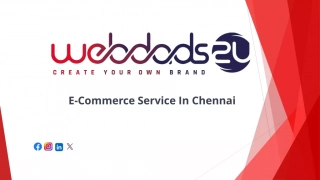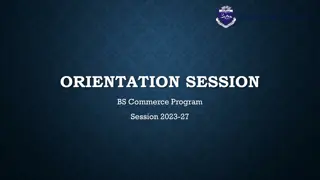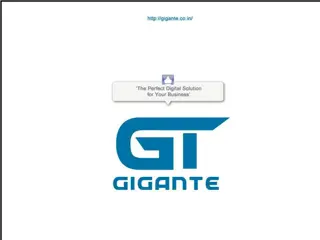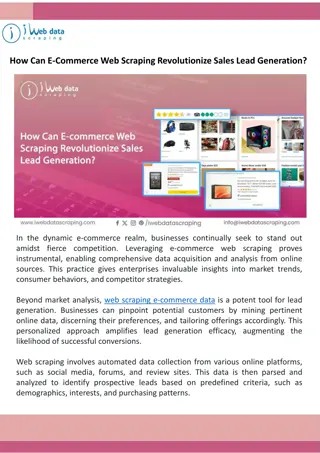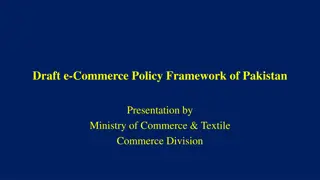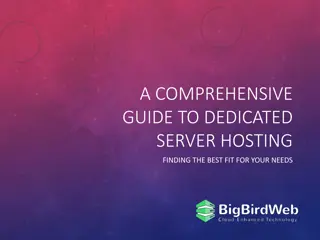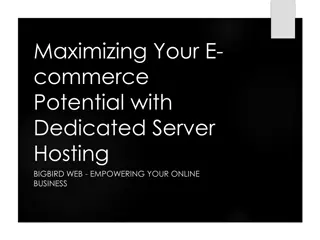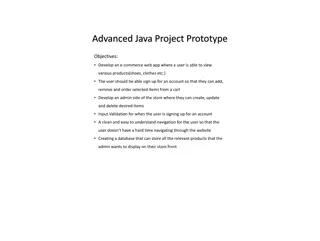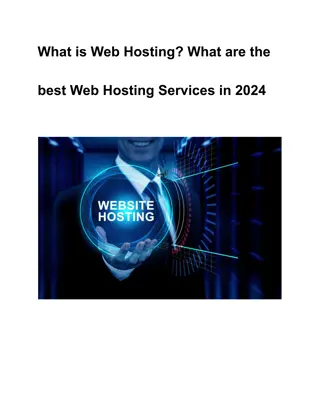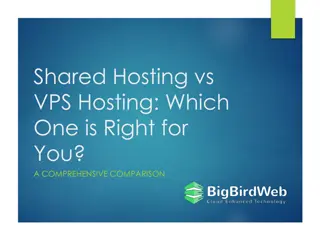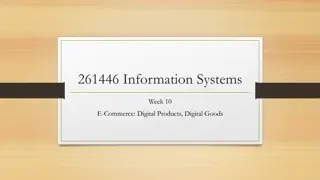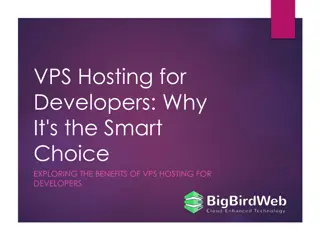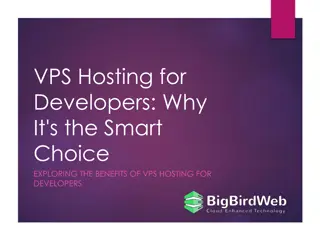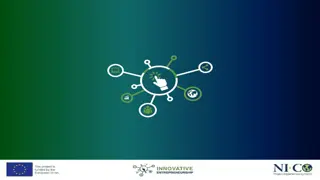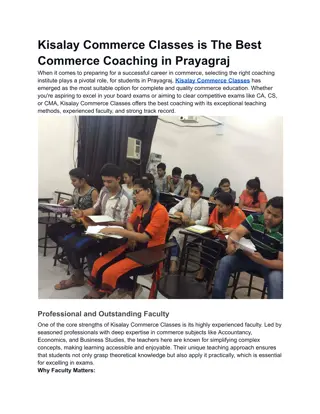Understanding E-Commerce Application Development and Web Hosting Services
Explore the essentials of e-commerce application development, web hosting services, and electronic commerce software functions. Discover different types of hosting alternatives, basic functions of e-commerce software, and the significance of catalog display in online stores.
- E-Commerce Development
- Web Hosting
- Electronic Commerce Software
- Catalog Display
- Hosting Alternatives
Download Presentation

Please find below an Image/Link to download the presentation.
The content on the website is provided AS IS for your information and personal use only. It may not be sold, licensed, or shared on other websites without obtaining consent from the author. Download presentation by click this link. If you encounter any issues during the download, it is possible that the publisher has removed the file from their server.
E N D
Presentation Transcript
COM 3105 E-COMMERCE APPLICATION DEVELOPMENT Hans Yip
Learning Objectives How to find and evaluate Web-hosting services What functions are performed by electronic commerce software How electronic commerce software works with database and ERP software What enterprise application integration and Web services are and how they can be used with electronic commerce software Which types of electronic commerce software are used by small, medium, and large businesses How electronic commerce software works with customer relationships management, knowledge management, and supply chain management software
Web Hosting Self-hosting is running servers in-house Most often used by large companies Third-party Web-hosting service providers offer Web services, electronic commerce functions Often used by midsize, smaller companies Commerce service providers (CSPs) provide Internet access and Web-hosting services Offer Web server management and rent application software Also called Managed service providers (MSPs) or Application service providers (ASPs)
Web Hosting Alternatives Web-hosting service options Shared hosting means client's Web site on a server hosting other Web sites simultaneously Dedicated hosting means the client Web server not shared with other clients Service provider owns and maintains server hardware, leases it to client, and provides Internet With co-location (collocation or colocation) service the provider rents physical space to client with a reliable power supply, Internet connection Clients install/maintain server hardware and software
Basic Functions of Electronic Commerce Software All electronic commerce solutions must provide Catalog display, shopping cart capabilities and transaction processing Larger complex sites may include software with added features and capabilities
Catalog Display Software Catalog organizes goods and services being sold May organize by logical departments Web store advantage is a single product may appear in multiple categories Catalog is a listing of goods and services Static catalog is a simple list written in HTML Must edit HTML to add or delete items Dynamic catalog stores information in a database with photos, detailed descriptions and a search tool for locating item and determining availability Both located in third tier of Web site architecture
Shopping Cart Software Early electronic commerce used forms-based shopping Shoppers selected items by filling out online forms which was awkward if ordering more than one or two items and error prone Electronic shopping carts are now standard Keep track of items customer selected and allows them to view cart contents, add and remove items Ordering requires a simple click which executes the purchase transaction Screen asks for billing and shipping information
Shopping Cart Software Web is a stateless system that does not retain information from one transmission to another Shopping cart software must store information Cookies allows information to be stored and retrieved Dynamic pricing management software adjusts prices in real time based on variables seller chooses Promotion management software allows sellers to create special offers on specific products
Shopping Cart Software Fulfillment integration software connects seller s shopping cart to fulfillment provider s computer Shipping automatically triggered at completed sale Product review management software allows customers to post reviews of products Product recommendation triggers are tools that respond to customer s product selection Provides suggestions for related products, refills Abandoned cart management software enables shopping cart to be retained for later when customer session is terminated
TYPICAL SHOPPING CART PAGE
Transaction Processing Occurs when shopper proceeds to virtual checkout counter by clicking the checkout button Electronic commerce software performs calculations Web browser software and seller s Web server software switch into secure communication state Electronic commerce software communicates with accounting software sales and inventory modules FedEx and UPS shipping rate software integrates with electronic commerce software Other calculations include coupons, promotions, time-sensitive offers
BASIC ELECTRONIC COMMERCE SITE ARCHITECTURE
How Electronic Commerce Software Works with Other Software Most large companies with electronic commerce operations also have substantial business activity unrelated to electronic commerce Important to integrate electronic commerce activities into the company s other operations Basic information system element is a collection of databases
Databases Highly structured information stored on a computer Business rules are how the company does business Database management software allows users to enter, edit, update, retrieve database information Distributed information systems are large systems storing data in many different physical locations Distributed database systems are databases within distributed information systems MySQL database is open-source software owned by Oracle and maintained by group of programmers
Middleware Middleware takes sales and inventory shipments information from electronic commerce software Transmits to accounting and inventory management software Companies can write their own or purchase customized middleware Middleware cost range is $30,000 to several millions Depending on complexity and existing systems
Enterprise Application Integration Application software (application) is a program that performs specific function like creating invoices Application server (computer) takes request messages received by Web server Runs application program performing action based on request message s contents Actions determined by business logic rules such as verifying customer password upon log in Enterprise application integration is a creation of links among scattered applications so business logic can be interconnected
Enterprise Application Integration As information is transferred from one application to another program data formats differ Must edit and reformat often using XML data feeds Page-based application systems return pages generated by scripts containing rules Present data on Web page with the business logic Component-based application systems separate presentation logic from business logic Logic components created and maintained separately Updating and changing system elements much easier
Integration with ERP Systems Enterprise resource planning (ERP) software are business systems integrating all facets of a business Accounting, logistics, manufacturing, marketing, planning, project management, and treasury functions Two major ERP vendors: Oracle and SAP ERP software installation costs between $1 million and $10 million for a midsize company Smaller online businesses can purchase products like NetSuite that offer ERP system subscriptions Called software as a service (SaaS)
ERP SYSTEM INTEGRATION WITH EDI
Web Services Software systems supporting interoperable machine-to-machine interaction over a network Set of software and technologies allowing computers to use the Web to interact with each other directly Does not require human operators directing the specific interactions Application program interface (API) is a general name for the ways programs interconnect with each other Web APIs: interaction over the Web
How Web Services Work Offer improved customer service, reduced costs Transmit XML-tagged data from one enterprise integrated application to another Provide data feeds between two different companies Programmers write software accessing business application logic units without knowing details Allows communication between programs written in different languages on different platforms Example task: transaction processing Can be combined with other Web services for complex tasks More advanced example is purchasing software used to obtain vendor price information Purchasing agent authorizes transaction and Web services submits order and tracks until delivered
Web Services Specifications Simple Object Access Protocol (SOAP) is a message-passing protocol Defines how to send marked up data from one software application to another across a network Utilizes three rule sets Communication rules included in SOAP specification Web Services Description Language (WSDL) describes logic unit characteristics of each Web service Universal Description, Discovery, and Integration Specification (UDDI) woks as address book to identify Web services locations and associated descriptions
REST and RESTful Design Representational State Transfer (REST) Principle describing how the Web uses networking architecture to identify and locate Web pages and elements making up those Web pages RESTful design (RESTful applications) are Web services built on the REST model Transfers structured information from one Web location to another Services accessible at a specific address More than half of all Web services today are RESTful applications



